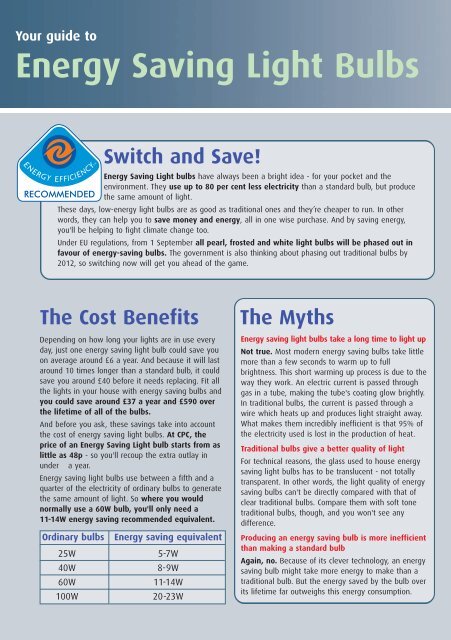Turn over for cpc's full range - CPC Ireland
Turn over for cpc's full range - CPC Ireland
Turn over for cpc's full range - CPC Ireland
You also want an ePaper? Increase the reach of your titles
YUMPU automatically turns print PDFs into web optimized ePapers that Google loves.
Your guide to<br />
Energy Saving Light Bulbs<br />
Switch and Save!<br />
Energy Saving Light bulbs have always been a bright idea - <strong>for</strong> your pocket and the<br />
environment. They use up to 80 per cent less electricity than a standard bulb, but produce<br />
the same amount of light.<br />
These days, low-energy light bulbs are as good as traditional ones and they’re cheaper to run. In other<br />
words, they can help you to save money and energy, all in one wise purchase. And by saving energy,<br />
you'll be helping to fight climate change too.<br />
Under EU regulations, from 1 September all pearl, frosted and white light bulbs will be phased out in<br />
favour of energy-saving bulbs. The g<strong>over</strong>nment is also thinking about phasing out traditional bulbs by<br />
2012, so switching now will get you ahead of the game.<br />
The Cost Benefits The Myths<br />
Depending on how long your lights are in use every<br />
day, just one energy saving light bulb could save you<br />
on average around £6 a year. And because it will last<br />
around 10 times longer than a standard bulb, it could<br />
save you around £40 be<strong>for</strong>e it needs replacing. Fit all<br />
the lights in your house with energy saving bulbs and<br />
you could save around £37 a year and £590 <strong>over</strong><br />
the lifetime of all of the bulbs.<br />
And be<strong>for</strong>e you ask, these savings take into account<br />
the cost of energy saving light bulbs. At <strong>CPC</strong>, the<br />
price of an Energy Saving Light bulb starts from as<br />
little as 48p - so you'll recoup the extra outlay in<br />
under a year.<br />
Energy saving light bulbs use between a fifth and a<br />
quarter of the electricity of ordinary bulbs to generate<br />
the same amount of light. So where you would<br />
normally use a 60W bulb, you'll only need a<br />
11-14W energy saving recommended equivalent.<br />
Ordinary bulbs Energy saving equivalent<br />
25W 5-7W<br />
40W 8-9W<br />
60W 11-14W<br />
100W 20-23W<br />
Energy saving light bulbs take a long time to light up<br />
Not true. Most modern energy saving bulbs take little<br />
more than a few seconds to warm up to <strong>full</strong><br />
brightness. This short warming up process is due to the<br />
way they work. An electric current is passed through<br />
gas in a tube, making the tube's coating glow brightly.<br />
In traditional bulbs, the current is passed through a<br />
wire which heats up and produces light straight away.<br />
What makes them incredibly inefficient is that 95% of<br />
the electricity used is lost in the production of heat.<br />
Traditional bulbs give a better quality of light<br />
For technical reasons, the glass used to house energy<br />
saving light bulbs has to be translucent - not totally<br />
transparent. In other words, the light quality of energy<br />
saving bulbs can't be directly compared with that of<br />
clear traditional bulbs. Compare them with soft tone<br />
traditional bulbs, though, and you won't see any<br />
difference.<br />
Producing an energy saving bulb is more inefficient<br />
than making a standard bulb<br />
Again, no. Because of its clever technology, an energy<br />
saving bulb might take more energy to make than a<br />
traditional bulb. But the energy saved by the bulb <strong>over</strong><br />
its lifetime far outweighs this energy consumption.







